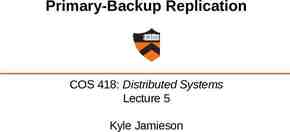Automotive Bearings and Sealants
49 Slides852.00 KB

Automotive Bearings and Sealants

Objectives Explain purpose of bearings Identify different types, construction, and uses of automotive bearings List types of lubricant used in a light vehicle Explain different types, construction, and uses of gaskets

Objectives Explain types and uses of chemical automotive sealants Explain different types, construction, and uses of seals

Objectives Explain the purpose of the various gaskets used to seal an engine. Identify the major gasket types and their uses. Explain general gasket installation procedures. Describe the methods used to seal the timing cover and rear main bearing.

Bearings and Bushings Bearings are used when two components move against or with each other Bearing Loads – Usually computed by weight and movement of load

Bearings and Bushings Bearing – – Loads Weight determines size, placement, and type of bearing to be used Thrust load looks at direction and amount of force against the weight

Bearings and Bushings Bearing – – – Journals and Races Machined areas on a shaft Provide a smooth finish to protect bearing Usually hardened to withstand loads

Bearings and Bushings Races – – – Serve same purpose as the journal Normally included with replacement bearing Assembled as part of bearing or can be loose

Bearings and Bushings Bearing – – – – Inserts Also known as “plain bearings” Used in engine as rod or main bearings Fitted into a mounting component Two pieces are needed to make one complete bearing

Bearings and Bushings Roller – – Bearings Support radial loads and small amount of thrust Typical roller bearing is fairly small and has several rollers trapped in a cage

Bearings and Bushings Roller – – – Bearings Cage holds bearings in a circle and maintains equal spacing Straight or tapered Needle bearings are also roller bearings May or may not be held in a cage

Bearings and Bushings Ball – – – – Bearings Similar to a roller bearing Highly machined steel balls versus rollers Support axial and radial loads well Sometimes two rows of balls are present to improve load support

Bearings and Bushings Bushings – – – – – Thin steel tubing cut to specific lengths Coated with copper Does not support axial loads Limits radial movement of a shaft Cannot be used in high-thrust or high-radial load areas

Inspecting and Repacking a Wheel Bearing Bearing failure is indicated by a noise from bearing area Bearing failure causes two types of damage – – Spalling Brinelling

Inspecting and Repacking a Wheel Bearing Dry bearings can weld themselves to the race or the component

Inspecting and Repacking a Wheel Bearing Remove suspected bearing and clean it thoroughly Dry bearing with compressed air Do not allow rollers or cage to spin

Inspecting and Repacking a Wheel Bearing Inspect each ball or roller for damage Inspect case and race for damage Any sign of damage warrants replacing bearing

Inspecting and Repacking a Wheel Bearing Repacking – – the Bearing Each roller or ball must be greased before installation Several types of repacking tools are available including compressed-air-powered

Inspecting and Repacking a Wheel Bearing Repacking – – the Bearing Bearing must be clean and dry before repacking Ensure grease extends up through bearing when complete

Lubricants Grease is used on roller and ball bearing components Grease must be matched to component and its usage Grease can be multipurpose Always consult service manual

Bearing Construction (Friction reducers) Friction Bearing- Two smooth surfaces sliding against each other Antifriction bearing- utilizes balls or rollers between moving parts

Antifriction bearings

Bearing Clearances Bearings must be tight enough to resist pounding but lose enough for oil to enter .002” .05mm

Oil Seals Oil is retained in the engine from Gaskets- cork or rubber Sealants-RTV-Room temperature vulcanizing Oil seals

Gasket Classifications Hard gaskets – Soft gaskets – Made of cork, rubber, or paper Silicone gasket material – Made of steel, copper, or a composite of metal and fiber Three different types Sealants – Usually in liquid form

Gaskets

Common Engine Gaskets Head – gaskets Have the most demanding job. Manifold – Are intake, exhaust, or combination. Valve – cover gaskets Must seal between different metals or materials. Oil – gaskets pan gaskets Seal between the block and pan.

Engine Gaskets and Seals

Gaskets Retain lubricants or to seal a chamber Head Gasket – – – Seals extremely high pressure of the combustion chamber Most head gaskets are a composite material Verify correct part for application

Gaskets Intake – – and Exhaust Must be designed to work in extreme heat Must be able to work between two different metals

Gaskets Other – – Gaskets Made from cork, synthetic rubber, neoprene, paper, and chemical-based Use the right gasket for the job at hand

Types of Sealants Aerobic – – sealants Cure only when exposed to oxygen (air). Are commonly used to form gaskets. Anaerobic – – sealants Cure only in the absence of oxygen (air). Are used for thread sealant.

Chemical Sealants Chemical – – sealers Gasket sealer Room temperature vulcanizing (RTV) sealer RTV cannot be used in high heat and high pressure applications

Chemical Sealants Cannot be used on fuel system components RTV color denotes application and temperature ranges

Seals Used between moving components and their housings to retain liquids Withstand high pressure and high temperatures Lip seals are most common type – Some have garter spring to hold seal tight to surface

Seals O-rings – – Rubber ring fits into a groove on moving or stationary component Extends beyond groove and pressed against second component

Seals Boots – – Used primarily to protect rather than seal Most common is CV joint boot

Oil Seal Designs Fiber-packing type Two-piece lip type One-piece radial type

Oil Seal Designs (Cont’d)

Sealants

Oil Seals

Summary Sealants include gaskets, chemicals, or seals Bearings must support axial and radial loads Gaskets used between stationary parts Seals used between moving parts O-rings are special purpose seals

Summary Gaskets serve as sealers, spacers, wear indicators, and vibration dampers. General recommendations for installing gaskets include the following: – – – Never reuse old ones. Clean all mating surfaces. Use sealants properly.

Summary (Cont’d) Head gaskets on today’s bi-metal engines have a demanding job. General-purpose sealers aid in gasket sealing without upsetting the performance of the gasket. Oil seals keep oil and other fluids from escaping around a rotating shaft.











